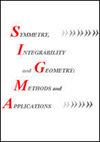信息几何、约当代数和协同类轨道构造
IF 1
3区 物理与天体物理
Q2 MATHEMATICS
Symmetry Integrability and Geometry-Methods and Applications
Pub Date : 2023-10-20
DOI:10.3842/sigma.2023.078
引用次数: 4
摘要
Jordan代数在(量子)信息几何中自然出现,我们想要了解它们在该框架中的作用和结构。受Kirillov关于伴随轨道上辛结构的讨论的启发,我们在实际Jordan代数的情况下提供了一个类似的构造。给定一个实数,有限维,形式实数Jordan代数${\mathcal J}$,我们利用由对偶${\mathcal J}^{\star}$上的Jordan积决定的广义分布,在该分布的叶上导出一个伪黎曼度量张量。特别地,这些叶是李群的轨道,李群是${\ mathical J}$的结构群,和伴随轨道很相似。然而,这一次,与lie -代数情况相反,我们证明了${\mathcal J}^{*}$中的并非所有点都位于正则Jordan分布的叶子上。当叶被包含在${\mathcal J}$上的正线性泛函的锥中时,伪黎曼结构变成了黎曼结构,并且,对于${\mathcal J}$的适当选择,它与有限样本空间上非归一化概率分布上的Fisher-Rao度量一致,或者与有限级量子系统的非归一化、忠实量子态的Bures-Helstrom度量一致,从而显示了约当代数数学与经典和量子信息几何之间的直接联系。本文章由计算机程序翻译,如有差异,请以英文原文为准。
Information Geometry, Jordan Algebras, and a Coadjoint Orbit-Like Construction
Jordan algebras arise naturally in (quantum) information geometry, and we want to understand their role and their structure within that framework. Inspired by Kirillov's discussion of the symplectic structure on coadjoint orbits, we provide a similar construction in the case of real Jordan algebras. Given a real, finite-dimensional, formally real Jordan algebra ${\mathcal J}$, we exploit the generalized distribution determined by the Jordan product on the dual ${\mathcal J}^{\star}$ to induce a pseudo-Riemannian metric tensor on the leaves of the distribution. In particular, these leaves are the orbits of a Lie group, which is the structure group of ${\mathcal J}$, in clear analogy with what happens for coadjoint orbits. However, this time in contrast with the Lie-algebraic case, we prove that not all points in ${\mathcal J}^{*}$ lie on a leaf of the canonical Jordan distribution. When the leaves are contained in the cone of positive linear functionals on ${\mathcal J}$, the pseudo-Riemannian structure becomes Riemannian and, for appropriate choices of ${\mathcal J}$, it coincides with the Fisher-Rao metric on non-normalized probability distributions on a finite sample space, or with the Bures-Helstrom metric for non-normalized, faithful quantum states of a finite-level quantum system, thus showing a direct link between the mathematics of Jordan algebras and both classical and quantum information geometry.
求助全文
通过发布文献求助,成功后即可免费获取论文全文。
去求助
来源期刊
CiteScore
1.80
自引率
0.00%
发文量
87
审稿时长
4-8 weeks
期刊介绍:
Scope
Geometrical methods in mathematical physics
Lie theory and differential equations
Classical and quantum integrable systems
Algebraic methods in dynamical systems and chaos
Exactly and quasi-exactly solvable models
Lie groups and algebras, representation theory
Orthogonal polynomials and special functions
Integrable probability and stochastic processes
Quantum algebras, quantum groups and their representations
Symplectic, Poisson and noncommutative geometry
Algebraic geometry and its applications
Quantum field theories and string/gauge theories
Statistical physics and condensed matter physics
Quantum gravity and cosmology.

 求助内容:
求助内容: 应助结果提醒方式:
应助结果提醒方式:


